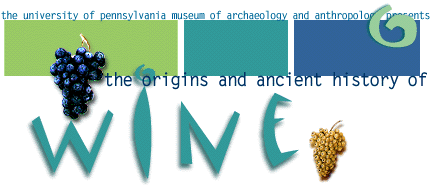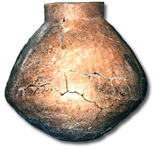 |
|||
 One of six jars once filled with resinated wine from the "kitchen" of a Neolithic residence at Hajji Firuz Tepe (Iran). Patches of a reddish residue cover the interior of this vessel. Height 23.5 cm. (Jar on display at the Penn Museum.) |
|
C
o n t e n t s :
|
|
Neolithic
Period
“Chateau
Hajji Firuz”
|
If winemaking is best understood as an intentional human activity rather than a seasonal happenstance, then the Neolithic period (8500-4000 B.C.) is the first time in human prehistory when the necessary preconditions for this momentous innovation came together. Most importantly, Neolithic communities of the ancient Near East and Egypt were permanent, year-round settlements made possible by domesticated plants and animals.
Crafts important in food preparation, storage, and serving advanced in tandem with the new cuisine. Of special significance is the appearance of pottery vessels around 6000 B.C. The plasticity of clay made it an ideal material for forming shapes such as narrow-mouthed vats and storage jars for producing and keeping wine.
A major step forward in our understanding of Neolithic winemaking came from the analysis of a yellowish residue inside a jar (see photo at top of page) excavated by Mary M. Voigt at the site of Hajji Firuz Tepe in the northern Zagros Mountains of Iran. The jar, with a volume of about 9 liters (2.5 gallons) was found together with five similar jars embedded in the earthen floor along one wall of a "kitchen" of a Neolithic mudbrick building, dated to ca. 5400-5000 B.C. The structure, consisting of a large living room that may have doubled as a bedroom, the "kitchen," and two storage rooms, might have accommodated an extended family. That the room in which the jars were found functioned as a kitchen was supported by the finding of numerous pottery vessels, which were probably used to prepare and cook foods, together with a fireplace. |
|
|
|
|
|
|

